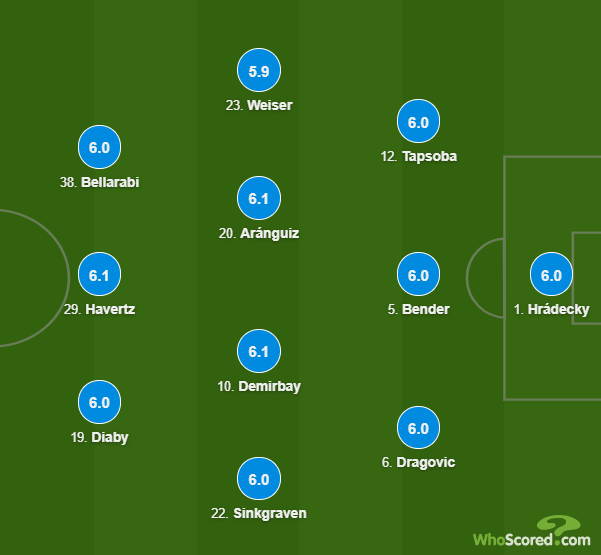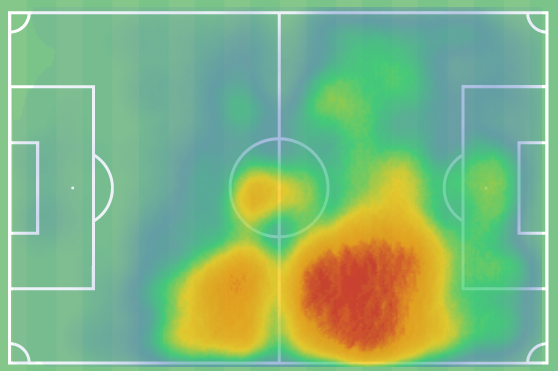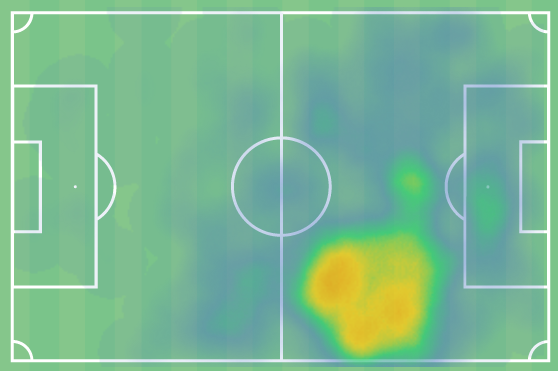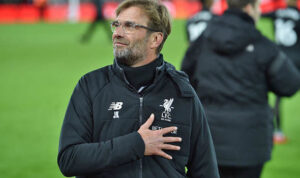Kai Havertz vs. Gladbach: Player Performance Review
In-depth video assisted analysis of Chelsea’s Kai Havertz’ performance for Bayer Leverkusen vs. Borussia Mönchengladbach. Creating, attacking, defending. Perhaps not what we might expect.
I will explore a game from the 2019/2020 season in Germany’s Bundesliga to see how Kai Havertz looked in one particular position: a center-forward with the supportive, fluid, expressive duty of a ‘false 9‘.
Chelsea have an exciting, expensive, explosive new look to their attack, and there are so many questions that will need answering during the 2020/21 Premier League season. Among the biggest questions is that regarding new £72,000,000 man Kai Havertz, a player with a big reputation and bigger potential, and where exactly he is going to fit in under Frank Lampard’s guidance.
Position
On May 23rd 2020, Bayer Leverkusen won a hard contested Bundesliga encounter with Borussia Mönchengladbach 3-1. Havertz initially began the game as the central figure of a front 3, flanked by two strong dribblers Karim Bellarabi and Moussa Diaby.

In the centre of the two, generally more advanced forwards, Havertz was given the opportunity to drop deep to contest duels, fight to recover, involve himself in the opening phases, and act as a general pivot between the combative midfield and the mobile, more direct runners in the final third.
Kai Havertz naturally favours his left, but he is adept and usually comfortable playing with either left or right foot; while he played in the centre vs. Gladbach, he has played in a number of different positions and roles for both Bayer Leverkusen and the German national team.
Havertz is capable of effective play in deeper, more traditional ‘playmaker’ roles, and can play as a wide forward, cutting-in to great effect with powerful, assertive running, or he can play off the shoulder of a centre forward in a supporting striker’s role.
Wherever the versatile forward finds himself, there often tends to be a willingness to occupy wide right areas, as is highlighted in his seasonal heatmap:

There is a clear favouring of the right side of the final third. This is explained in part by Kai Havertz often playing a right side attacking midfield or inside forward position, but we can isolate his Bundesliga heat maps to the ten games when he played as a centre forward, including the win over Gladbach, and the results remain similar:

He isn’t a centre forward in the traditional sense, Havertz is not often the most advanced forward, playing ahead of the ball; there is a natural desire to drop deeper in order to receive the ball, Havertz wants to be involved in the early to mid phases of attacking play. Plenty of duels contested, plenty of recoveries and interceptions, and plenty of input into the creative phases; Kai Havertz isn’t a striker, but he’s more than an attacking midfielder.
Progression
A progressive run is defined as a “continuous ball control by one player attempting to draw the team significantly closer to the opponent goal“; there are a number of really demonstrative examples of Havertz and progressive running in the Gladbach game.
The first was slightly different from what we would usually classify as an effective progressive run, but it does well to highlight the positive intention of Kai Havertz as he picks up the ball in the middle third.
Upon possession turning over, Havertz accelerates between midfield markers. The pass he receives is too direct to feet for him to run on to it, and he is closed down quickly. He moves it on to his teammate, occupying the wing, and takes up a position in a pocket of space between defenders.
There is no easy passing lane, so the ball is defended well, but the intention is excellent. Havertz tends to make the right call in terms of his movement and positioning, even if those around him don’t.
The next example is more typical of a progressive run.
Havertz is deep within his own half when he collects the clearance facing his own goal. His pass is considered and controlled but not particularly impressive. What is impressive was the immediate recognition of progressive potential.
He runs wide of his marker, opening the angle for a straight pass. He trusts his pace to beat his man and he beats him well. Havertz isn’t an accelerator; but those long, sinewy legs do take big controlled strides, meaning he is a fast runner over the longer distances.
He wins the race and is inside the Gladbach box ten seconds after first receiving the ball. Havertz entirely maximised his position and, with the help of a well-weighted pass, created a promising chance from very little.
The final example shows Havertz performing the job of a real false 9. The point man who will come deep to receive the ball, control it, and allow wide runners to advance into space.
Leverkusen recover the ball inside their own 18-yard box. Havertz is running from his usual right half-space into a central area close to the halfway line, dragging his marker with him. Heading back towards his own goal, between pressing forward opponents, he cuts through them and turns back to the right side before finding his teammate with a no-fuss short pass.
With a short dribble towards his own goal, and a quick turn and pass, Havertz has eliminated the opposition midfield and allowed his team to advance into more effective offensive areas.
Again, the most impressive aspect is the decision making. Whether he peels wide to give himself space to beat his marker for pace, or heads seemingly into trouble in order to provide an opportunity for teammates to advance ahead of him, his decisions are usual justified. Havertz trusts his ability, both physically and technically, and doesn’t hesitate in making those calls.
Shooting
Havertz scored twice in this game. His first goal is the one I will focus on here (the second goal was notable for another aspect of his game, which I will get to later).
Gladbach give the ball away in a dangerous central area, Leverkusen’s three attackers come to life. I said Havertz isn’t an accelerator but he is fast, and this shows again here.
The marking centre back is turning and uncomposed and has little option in keeping up with Havertz. The forward simply has to run between defenders and hope the through pass is timed well. Bellarabi times his pass expertly and Havertz is one on one. It’s a really well worked technical move.
The most impressive aspect here, though, is not the run nor the pass nor the move itself, it was that finish.
Havertz has watched the ball the whole way; the pass was so well-weighted that a controlling steadying touch is entirely unnecessary; Havertz’ confidence is such that he doesn’t need a touch to assess his options. Waiting for the goalkeeper to commit, and with the slightest glance, Havertz slots the ball calmly through the ‘keeper’s legs and in.
The second example is a different kind of run, though no less effective, and a different kind of finish.
Creative Passing
Havertz’ second goal against Gladbach was a penalty late in the second half; he was instrumental in the awarding of the penalty and we’ll focus first on that. It won’t be officially recorded as an assist, but we can probably, in this case, regard it as such.
Havertz is found on the right, between the lines; his control is smooth and allows for a natural movement to make the pass in one single fluid motion. With a very controlled left foot, he sweeps a perfectly timed and weighted ball through a keyhole for Bellarabi to win the penalty.
The pass is nice; very smooth and executed effectively enough to create the chance and the eventual goal, but the big aspect here is again the positioning. It’s a playmakers’ position. If we are looking at things through the lens of traditional numbers meaning position, Havertz played the 10, 9 and 7 against Gladbach. For this goal, he was the 10. Sitting in the pocket between defensive and midfield lines, he is primed to control, swivel and release the ball. Very fast, very efficient, and very effective.
The second example sees Havertz taking up a deeper position as a 10, dropping back to the D. This is an area his new manager, Frank Lampard, knows very well. The Chelsea man was among the very best operating in zone 14.
The beauty of this move is as much to do with Moussa Diaby as it is Havertz. The young Frenchman, after finding his teammate, makes his own diagonal run to stretch the defensive line, which brings a marker with him and opens up an avenue for Havertz after he plays the short pass to Leon Bailey.
Bailey decides to take on the shot from an inopportune area; the blockers are well set and there there isn’t a clear pathway to goal from that position. He has a runner wide, he has Diaby ahead, and, most notably, he has Kai Havertz advancing between defenders to the penalty spot.
Not easy to find, and most players have their minds made up long before they consider which option is best. Hesistation in offensive areas is not usually beneficial; but Havertz’ run, as well as Diaby’s, deserve a better decision from Bailey.
Here Havertz showed a playmaker’s intelligence to drop back and assist play, and then a forward’s instinct to spot the gap created by his teammate, move towards it and time the run with the hope that the pass is made.
Whether assisting a runner or providing the run, against Gladbach Havertz was comfortable. There was an instinctive drive and desire to be involved, either through the first movement and positioning or later running into advanced attacking areas.
Defensive Output
Defensive output from an attacker, in this case a centre forward, can be expressed and analysed in different ways. Against Gladbach, Havertz wasn’t running across his lines to trigger and lead a counter-press, he wasn’t flying into tackles and hassling defenders; Havertz did his duty in defensive zones (he was simply there), he was ready to compete for duels, both on the ground and aerially, and, most of all, he was primed to intercept and recover the ball.
Here we have a blocked pass – classified as an interception in this case – and dispossession of the attacker in the penalty area.
Havertz takes up position a short way ahead of his main defensive line, tasked with marking the zone in the central to far post area. His tracking run is fine, and the defensive positioning very good; the issue is in the timing of his jump.
His position enables him to win the ball, but his badly timed jump means the header is soft, misdirected, and the clearance is directly up rather than out. The second ball is cleared by the defender behind Havertz, but the manner of the flight of the ball leaves it headed understandably without pace or conviction.
Most of the aerial duels Havertz contested were in the opposition half and can be considered offensive. There were a number of long ‘route one’ passes directly from goalkeeper to centre forward, and Havertz’ good starting positions and upper body strength meant he won plenty of these.
This is an example of the upper body strength:
And an example of excellent positioning and timing:
Havertz the target man is likely not an avenue he will find himself going down too often at Chelsea, but it is clearly one that Leverkusen felt he could offer effectively, though he isn’t a natural. The examples of him winning the high balls show the kind of positional sense we’ve come to expect, and also a level of physical strength that some may not have known Havertz possesses; but he also lost plenty of aerial duels.
I’ve put them together in one clip:
Almost all of these balls are lost not due to Havertz being bullied physically or being out of position, they are lost almost entirely due to Havertz misjudging either the flight of the ball or the timing of his attacking of the ball. Judgement and timing come with experience.
I can’t imagine Kai Havertz will ever be a typical ‘target man’ number 9, but the ability to effectively win a high ball, whether it’s a long clearance or a cross or a progressive long pass into the penalty area, is a vital skill. He already shows good ability with the foundations – the strength and positioning – but lacks the experience to correctly apply timing.
Promise
That’s the keyword: ‘Promise’. Kai Havertz is full to brim with potential, and the kind of form he has shown to date shows he is well on his way to fulfilling it. He is difficult to categorize in a typical positional sense; he is difficult to typecast in a particular role; Kai Havertz is as versatile in his skill set as he is skilled.
In the Gladbach game, Havertz showed the kind of habitual instinctive play we usually expect from a seasoned playmaker – taking up positions in the hole, swivelling to set the body for an immediate through pass without hesitation, displaying vision and the ability to pick and play a pass while needing very little time to consider options.
Havertz showed the positional opportunism we usually expect from a confident inside forward – occupying the half-spaces, primed and ready to cut inside, check back, run beyond the last man, move between zones 15 and 14; very difficult to mark, track and, usually, difficult to stop.
He shows intelligent in his movement, in both defensive and offensive areas; the running was often so clever his teammates weren’t able to oblige. There were times Havertz seemed to be many levels beyond his team, and this is was a very good, very talented team.
Kai Havertz is a truly fascinating player full of promise.
Unless otherwise credited, The videos used in this analysis belong to BT Sport, Fox Sports and Bundesliga, the tactical times do not claim to own any of the visual or audio media presented here. This analysis was created under Fair Use (17 U.S.C. § 107) and may not be copied, redistributed, edited or altered without the express permission of the copyright holder.


